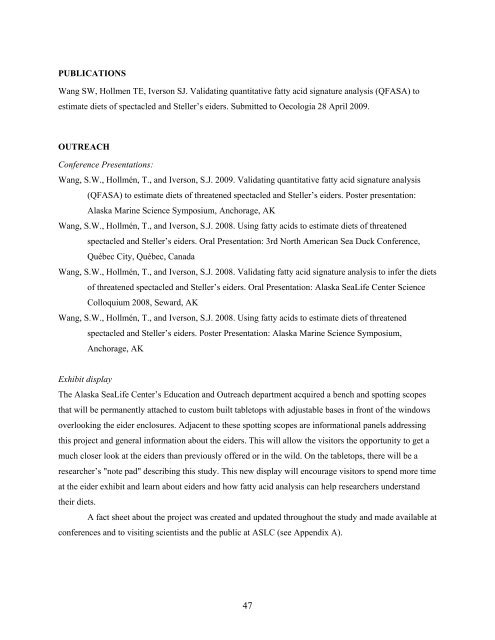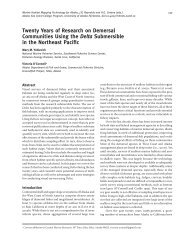724_Final Report.pdf - North Pacific Research Board
724_Final Report.pdf - North Pacific Research Board
724_Final Report.pdf - North Pacific Research Board
You also want an ePaper? Increase the reach of your titles
YUMPU automatically turns print PDFs into web optimized ePapers that Google loves.
PUBLICATIONS<br />
Wang SW, Hollmen TE, Iverson SJ. Validating quantitative fatty acid signature analysis (QFASA) to<br />
estimate diets of spectacled and Steller’s eiders. Submitted to Oecologia 28 April 2009.<br />
OUTREACH<br />
Conference Presentations:<br />
Wang, S.W., Hollmén, T., and Iverson, S.J. 2009. Validating quantitative fatty acid signature analysis<br />
(QFASA) to estimate diets of threatened spectacled and Steller’s eiders. Poster presentation:<br />
Alaska Marine Science Symposium, Anchorage, AK<br />
Wang, S.W., Hollmén, T., and Iverson, S.J. 2008. Using fatty acids to estimate diets of threatened<br />
spectacled and Steller’s eiders. Oral Presentation: 3rd <strong>North</strong> American Sea Duck Conference,<br />
Québec City, Québec, Canada<br />
Wang, S.W., Hollmén, T., and Iverson, S.J. 2008. Validating fatty acid signature analysis to infer the diets<br />
of threatened spectacled and Steller’s eiders. Oral Presentation: Alaska SeaLife Center Science<br />
Colloquium 2008, Seward, AK<br />
Wang, S.W., Hollmén, T., and Iverson, S.J. 2008. Using fatty acids to estimate diets of threatened<br />
spectacled and Steller’s eiders. Poster Presentation: Alaska Marine Science Symposium,<br />
Anchorage, AK<br />
Exhibit display<br />
The Alaska SeaLife Center’s Education and Outreach department acquired a bench and spotting scopes<br />
that will be permanently attached to custom built tabletops with adjustable bases in front of the windows<br />
overlooking the eider enclosures. Adjacent to these spotting scopes are informational panels addressing<br />
this project and general information about the eiders. This will allow the visitors the opportunity to get a<br />
much closer look at the eiders than previously offered or in the wild. On the tabletops, there will be a<br />
researcher’s "note pad" describing this study. This new display will encourage visitors to spend more time<br />
at the eider exhibit and learn about eiders and how fatty acid analysis can help researchers understand<br />
their diets.<br />
A fact sheet about the project was created and updated throughout the study and made available at<br />
conferences and to visiting scientists and the public at ASLC (see Appendix A).<br />
47



